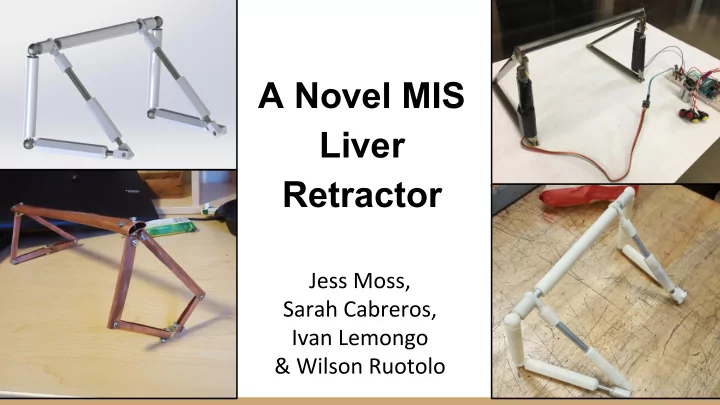

A Novel MIS Liver Retractor
Suturing Technique Umbilical Tape Endograb
Normal Liver Fatty Liver Enhanced CT
Specific Aim # 1: Design a liver retraction device that is both robust and MIS compatible. Hypothesis 1.3: A folding pattern with necessary joints will allow for insertion and setup of a pre-assembled bracing structure and can be completed by a trained surgeon in comparable or faster time than the current art of liver retraction technology.
Task 1.1: Design a bracing structure that distributes force across the peritoneum and supports the liver at least 10 cm above the hiatus . First Prototype Initial Idea Sketches Refined Design Second Prototype
Task 1.2: Create a liver retracting device capable of fitting through a standard 10mm MIS port .
Task 1.2: Continued Initial Folding Mechanism Prototype 3D Printed Prototype in Insertion Configuration CAD Model Of Device in Insertion Configuration
Specific Aim # 2: Integrate post-insertion control of the device so as to ensure the surgeon can fine tune the shape of their desired work space. Hypothesis 2.2: Visual feedback from traditional MIS cameras is sufficient for the surgeon to accurately finalize the device configuration using the control scheme designed in Task 2.1.
Task 2.1: Implement remote actuation of the supporting legs of the structure designed. Prototype with gelatin tissue phantom Extension and retraction of Micro linear actuator linear actuators
Specific Aim 3: Distribute tool-tissue contact area of the device to reduce stress concentrations in surrounding tissue. Hypothesis 3.2: The device designed will sufficiently distribute force so as to not perforate or otherwise damage the load bearing tissues of the peritoneum even under the increased load necessary to support a fatty liver.
Task 3.1: Analyze and adapt primary loading areas of the device so as to eliminate sharp edges and maximize surface area of contact within the limits imposed by the MIS insertion procedure.
Surgical Trials
Surgical Trials 1. Standardized procedure on porcine cadavers using our device
Surgical Trials Hypothesis 1.3: The device can be assembled quickly 1. Standardized procedure on porcine cadavers using our device 2. Timed components of the procedure with a focus on insertion and setup
Surgical Trials 1. Standardized procedure on Hypothesis 2.2: Traditional MIS cameras are sufficient porcine cadavers using our feedback for positioning of the device device 2. Timed components of the procedure with a focus on insertion and setup 3. Video review to assess level of hiatal exposure Palanivelu, Praveenraj, et al. "Review of various liver retraction techniques in single incision laparoscopic surgery for the exposure of hiatus." Journal of minimal access surgery 11.3 (2015): 198.
Surgical Trials Hypothesis 3.2: The device will diminish stress concentrations 1. Standardized procedure on porcine cadavers using our device 2. Timed components of the procedure with a focus on insertion and setup 3. Video review to assess level of hiatal exposure 4. Open cavity postoperative inspection to quantify total tissue damage
Recommend
More recommend